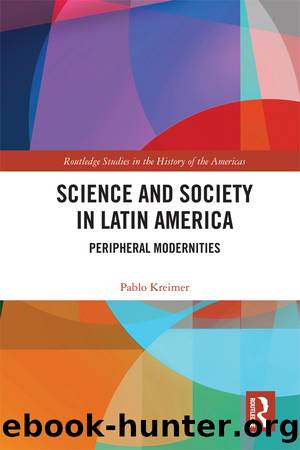Science and Society in Latin America by Pablo Kreimer

Author:Pablo Kreimer [Kreimer, Pablo]
Language: eng
Format: epub
Tags: History, General, Latin America
ISBN: 9780429561153
Google: pQWQDwAAQBAJ
Publisher: Routledge
Published: 2019-04-02T03:00:15+00:00
Concluding Remarks
The entire period can be understood as a succession of transitions and slow generational renewal before, in a roundabout way, it reaches the foundation of a new, fairly autonomous field. The process of transition bears the following specific features.
First is the imitative nature of molecular biology arising from new lines of research, which we call subordinated integration. In other words, topical and conceptual innovation is due to the adoption of lines and techniques of research developed in laboratories belonging to the mainstream of international science through postdoctoral education abroad and a subsequent return to Argentina. Over time, this throws up networks of cooperation between âsuccessfulâ local researchers and foreign centers of education. At the same time, it leads to a segmentation of local research groups into those that do manage to fit into these networks and others that do not.
Second comes the persistence of âcrystallizedâ scientific traditions resistant to the emergence of new disciplines. With the âadoptionâ of lines of research already developed abroad, molecular biology as a ânew disciplineâ plays an auxiliary technical role during a first transition stage. In a second stage, the discipline begins to consolidate itself as an autonomous field of knowledge with a growing number of research groups characterized by âtopical ultra-specializationâ. This hampers participation in the conceptual issues behind the adopted topics.
This last feature has even given rise to rhetorical reconstructions by traditional researchers. According to this interpretation (which tends to play down the various schisms and watersheds), there ought to be a continuity between physiology, biochemistry, and molecular biology (genetics is not usually mentioned in this interpretation) in which each discipline represents a technical leap forward that does not derive from schisms in their ways of conceiving of the biological universe.
According to this form of conceptual innovation, the adoption of new problems, theoretical approaches, and research techniques that are not well developed locally encourages research practices with a heavy experimental bias (which confers reliability on any data obtained) and an intense concentration on a handful of research problems (topical ultra-specialization). This culminates in low levels of participation in general conceptual problems and leads to what we call a hypernormal science. Once the discipline has been âcrystallizedâ, it hinders conceptual innovation, and this is associated with difficulty in reinvesting the capital accumulated in new, uncertain frontiers of knowledge.
By the mid-1950s, the field of biochemistry was at its peak as a typical disciplinary space, internationally and locally. The essential principles of the paradigm had been around for several decades, and there was a whole âspace of sociabilityâ tied in with academic practices, local and international associations, specialized journals, and international events that constituted a powerful legitimation network. Biochemistry in Argentina had largely been established by Bernardo Houssay, the exclusive protagonist of scientific professionalization in the country, a central player in the development of physiology and self-appointed leader of a whole generation of researchers. Also involved were several of his students such as Luis Leloir (first at UBA and then at Bernardo Houssayâs own Institute
Download
This site does not store any files on its server. We only index and link to content provided by other sites. Please contact the content providers to delete copyright contents if any and email us, we'll remove relevant links or contents immediately.
Cat's cradle by Kurt Vonnegut(15251)
Pimp by Iceberg Slim(14433)
4 3 2 1: A Novel by Paul Auster(12328)
Underground: A Human History of the Worlds Beneath Our Feet by Will Hunt(12050)
The Radium Girls by Kate Moore(11967)
Wiseguy by Nicholas Pileggi(5706)
The Fire Next Time by James Baldwin(5379)
Perfect Rhythm by Jae(5354)
American History Stories, Volume III (Yesterday's Classics) by Pratt Mara L(5274)
Paper Towns by Green John(5136)
Pale Blue Dot by Carl Sagan(4950)
A Higher Loyalty: Truth, Lies, and Leadership by James Comey(4904)
The Mayflower and the Pilgrims' New World by Nathaniel Philbrick(4456)
The Doomsday Machine by Daniel Ellsberg(4447)
Killers of the Flower Moon: The Osage Murders and the Birth of the FBI by David Grann(4406)
The Sympathizer by Viet Thanh Nguyen(4336)
Too Much and Not the Mood by Durga Chew-Bose(4301)
The Borden Murders by Sarah Miller(4270)
Sticky Fingers by Joe Hagan(4142)
